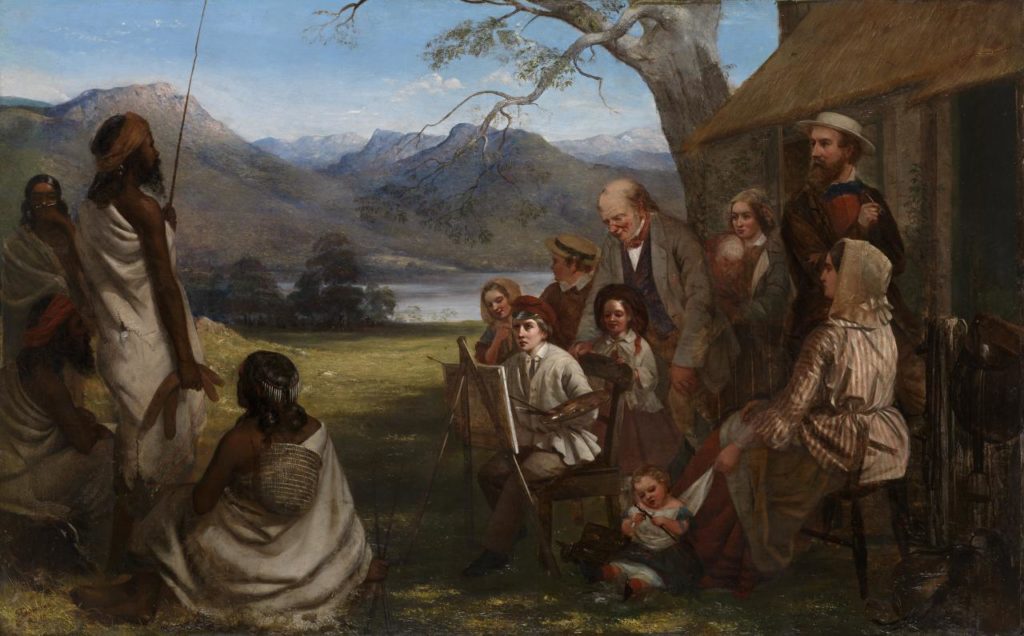Visions of Eden: The State of Nature as Idyll
The story of Adam and Eve’s life in the Garden of Eden and their fall from grace is a central myth in Western thought. For centuries it has captivated the imagination of artists, theologians, and political thinkers alike, generating vast and far-reaching echoes. The first chapters of Genesis have in fact been crucial in informing understandings of the relationship between mankind and the environment, of the function of technology, of the flow of history, and of the human condition. The myth has also had a particularly strong influence in framing perceptions of the non-European “indigenous” other, creating a long-lived portrayal of non-industrial people as the innocent and authentic dwellers of an idyllic environment with which they live in complete harmony. Elements of this discourse survive in contemporary descriptions of indigeneity and in debates surrounding the notion of “Civilization”.

Hieronymus Bosch, detail from The Garden of Earthly Delights (c. 1490-1510). Collection of Museo del Prado, Madrid.
According to the story, before flouting the divine order not to eat from the Tree of Knowledge, Adam and Eve lived in harmony with the natural world and their creator, and all that was needed for their subsistence could be found in abundance. In the years of the European discovery and exploration of the New World, this idyllic vision of a prelapsarian Eden was a common frame of reference for portrayals of the indigenous people encountered in expeditions.
In Columbus’s diary of his first voyage, compiled by his son Ferdinand Columbus, the lushness and beauty of the newly discovered lands were praised enthusiastically, and the inhabitants were described as kind-hearted and innocent. “[N]o one could believe that there could be such good-hearted people,” Ferdinand wrote, “so free to give, anxious to let the Christians have all they wanted, and when visitors arrived, running to bring everything to them.”[1] Or, in Christopher Columbus’s own words: “[T]hey are loving people, without covetousness….They love their neighbors as themselves, and their speech is the sweetest and gentlest in the world, and always with a smile. Men and women go as naked as wen their mothers bore them.”[2]
Although such positive portrayal of lands and people was strategic for Columbus,[3] who had to reassure the Spanish crown of the value of their investment in his expedition, descriptions from contemporary authors summon analogous visions. In his vivid text from 1542, A Short Account of the Destruction of the Indies, Dominican friar Bartolomé de Las Casas denounced the massacres and devastation perpetrated by the Spanish against the native populations of Central and South America and depicted indigenous inhabitants in similar terms. These were in fact
as open and as innocent as can be imagined. The simplest people in the world – unassuming, long-suffering, unassertive, and submissive – they are without malice or guile….Never quarrelsome or belligerent or boisterous, they harbour no grudges and do not seek to settle old scores; indeed, the notions of revenge, rancour, and hatred are quite foreign to them….[T]hey own next to nothing and have no urge to acquire material possessions. As a result they are neither ambitious nor greedy, and are totally uninterested in worldly power….[4]
Although Columbus’s and De Las Casas’s portrayals are extremely positive, contemporary descriptions of South American Indigenous people were much more varied. Other authors and chroniclers did not hesitate to define the natives primarily in terms of their idleness and brutality, but it is the longevity of the Edenic vision that I wish to focus on in this article. The emphasis on childlike qualities, and its association with freedom from the corrupting influence of an excess of “material possessions” or artificiality, was frequent also in later portrayals. In Romantic times, when European societies were beginning to face the issues brought about by industrialization, the vision of indigenous people living in harmony with nature was present in contemporary portrayals of life outside a civilized order perceived as oppressive and dehumanizing. Italian poet and philosopher Giacomo Leopardi (1798-1832), for example, was one of the most bitter critics of modernity, and posited a radical opposition between civilized people and idealized “savages.” While civilized people had contrived manners, repressed emotional outbursts, and masochistically created artificial needs which did not exist in the state of nature, “savages” were genuine in their expressions of feeling and were content with living in the natural world.

Robert Dowling, Early effort – Art in Australia (c. 1860). Collection of National Gallery of Victoria, Melbourne.
Leopardi’s writings were pervaded by an association of the civilized state with the artificial and the modern, and of the state of nature with the authentic, primordial time conceived of as the infancy of humanity. He often individuated parallels between children, savages, and primitives, and described them as sharing the same uncontrived and spontaneous approach to life. This parallel was to gain importance in the anthropological evolutionary theories of human development spreading between the late nineteenth and early twentieth centuries. These delineated progress as a teleological development from savagery to civilization, where the state of nature coincided with the infancy of mankind.[5]
Most importantly, Leopardi believed primitive men and savages to live in complete harmony with their natural state. The Californian natives, for example,
[live in] hot temperatures which spare them the need for fire, no less than they do the need for clothes, and feeding themselves only on grass, roots, and fruit and on animals which they are able to catch, overcome, and take with their own hands unarmed, and other similar things, but all raw. And incidentally those Californians are physically hundreds of times healthier, stronger, more cheerful in aspect, and certainly happier in terms of morale and inwardly, than are the Europeans.[6]
On the contrary, according to the author, an irreparable rupture characterized the relationship between “civilized” men and the environment. Modern men found in fact the latter distasteful or unsuitable to satisfy their needs if left uncultivated or unaltered, and they were incapable of living without resorting to all sorts of artifices. These in turn created an infinite number of “artificial” necessities that needed to be addressed with equally artificial means, causing civilized people to live in constant wretchedness. What we think of as technological and scientific progress was therefore only a degeneration or a corruption from the idyllic state of nature.
Although Leopardi laid out his conception of progress nearly two centuries ago, some of its arguments have a familiar and contemporary ring. The understanding that life in a capitalist, urban, and consumeristic order may be fundamentally “unnatural,” the longing to return to a state of harmony with the natural world, and the perception that modern life is characterized by a damaging excess of artificiality and artificial diversions are all common features of critiques of modernity. Most relevantly, the image of the Indigenous person as being more attuned to the natural environment, and of being somewhat alien to the dynamics of distancing described above, still has a place in the common imagination and in mass media.
Just to give one of the innumerable examples available: on the National Geographic blog, “uncontacted” tribes are described as “the last free people on earth,” “free from the influence of governments, the subliminal powers of advertising and the media and the thoughts of others,” experiencing towards their “homeland” “a strong practical and emotional connection felt by most tribal peoples.” Stephen Corry, anthropologist and director of Survival International, is quoted as saying:
In our relentless search for ‘development’ and material progress it is possible we have alienated ourselves from our deepest human needs, which surely lie in our connections to each other and the Earth….Tribal peoples still perhaps understand those connections better than most.
Such views are aired on countless outlets on TV and the internet, contrasting nature and civilization and emphasizing the corrupting power of the latter.
In a book chapter from The Reinvention of Primitive Society: Transformations of a Myth titled “The Return of the Native” (online version available here), anthropologist Adam Kuper demonstrates how such antiquated conceptions of non-industrial people are still present in contemporary arguments advanced by indigenous-rights movements. The anthropologist expresses a concern for how “discredited old arguments may lurk behind new words,” as the terms “native” or “indigenous” are often used as euphemisms for the same people that had once been described as primitive, tribal, hunting, or nomadic. Indeed, when the United Nations Permanent Forum on Indigenous Issues was founded in 1995, its members represented groups that had been the quintessential “primitive societies” defined by classical ethnographies.
Kuper is highly skeptical of the rhetoric of Indigenous rights activists, and he lays out the insidious implications of arguments adopted in support of their cause. One of such arguments is the claim that descendants of a certain Indigenous population have the usufruct, or right to use, of lands that were occupied by their forbearers, while people that settled in the territory at a later stage are guests, or migrants, and should be treated as such. These propositions, Kuper remarks, are characteristic of European right-wing parties, but they are considered acceptable when advanced in support of the cause of Indigenous people. And not only that:
[W]here hunters and nomadic herders are concerned, the principle is sometimes taken even further. It is then argued that they represent not merely the first inhabitants of a country but the original human populations of the world. In a certain sense primitive, aboriginal, humankind’s firstcomers, theirs is also the natural state of humanity.[8]
Here we see how far-reaching the association between indigeneity, childhood, and a “natural state” is, as such claims are not too distant from Leopardi’s idealized conception of “savage people.”
Kuper challenges a second stereotype which lives on in the rhetoric of Indigenous rights movements: the assumption that Indigenous people live attuned to nature, unlike farmers, city-dwellers, or other categories of the human population. Viewed in opposition to a sedentary and consumerist mode of life, these societies are romanticized, assumed to be inspired by spiritual rather than materialistic values. Kuper quotes the words of Boutros Boutros-Ghali, UN Secretary General at the time of the foundation of the Permanent Forum for Indigenous Issues, who claimed: “[I]t is now clearly understood that many indigenous people live in greater harmony with the natural environment than do the inhabitants of industrialised consumer societies.”[9]
Citing the cases of the Inupiat of Alaska’s North Slope supporting oil drilling in the Arctic National Wildlife Refuge, or the Inuit Home Rule government of Greenland, which supports the exploitation of non-renewable resources, Kuper demonstrates that it is certainly not uncommon for Indigenous groups to object to “traditional” practices of subsistence, opting instead for oil drilling, industrial production, and the founding of Indigenous-controlled profit-making corporations.
Thus, although the motivations behind Indigenous rights movements are certainly generous, and have been supported by development agencies, NGOs, and the United Nations, Kuper remains doubtful about the “justice and good sense” of many of these initiatives. The discourses described above have in fact very concrete consequences, since they have resulted in large portions of land being conceded to very small communities “defined in terms of descent,” reviving theories which would be unacceptable in any other context and linking bloodlines to territories.[10] At the same time, policies based on the restitution of traditional lands and hunting rights have created local tensions between groups defined through criteria that are “uncomfortably racist,” creating new problems rather than addressing pre-existing ones at the root.[11]

Example cited by Susan Goldberg of the racist tropes in National Geographic‘s photojournalism
With his article, Kuper shows that the long-lived myth of a prelapsarian humanity fully in touch with the environment is still present in contemporary portrayals of “indigenous people.” Indeed, in this month’s issue of National Geographic, Editor-in-Chief Susan Goldberg confronted such issues of representation in the history of the publication, drawing attention to the familiar tropes discussed above. African “natives,” Goldberg states, were almost exclusively pictured “as exotics, famously and frequently unclothed, happy hunters, noble savages.” Technology also had a particular role in this portrayal, as “indigenous people” were often photographed as being “fascinated by Western technology,” furthering a dichotomy between the civilized and uncivilized. Issues of (mis)representation of “native” people are thus still the matter of intense debate, and demonstrate that there is far more at stake, in such portrayals, than intellectual honesty.
[1] Sir Clements R. Markham trans., Journal of the First Voyage of Columbus, (London, 1893; American Journeys, 2003), 191, http://www.americanjourneys.org/pdf/AJ-062.pdf
[2] Ibid., 201.
[3] Matthew Restall, Seven Myths of the Spanish Conquest (Oxford: Oxford University Press, 2004).
[4] Bartolomé de Las Casas, A Short Account of the Destruction of the Indies, Nigel Griffin trans., 9-10, http://www.columbia.edu/~daviss/work/files/presentations/casshort/
[5] Heather Montgomery, An Introduction to Childhood: Anthropological Perspectives on Children’s Lives (New York: John Wiley & Sons, 2011)
[6] Gioacomo Leopardi, Zibaldone: The Notebooks of Leopardi (London: Penguin UK, 2013), 1498-9.
[7] Adam Kuper, The Reinvention of Primitive Society: Transformations of a Myth, 2nd ed. (London: Routledge, 2005), 203-4.
[8] Kuper, 205.
[9] Kuper, 207.
[10] Kuper, 217.
[11] Ibid.



Dilettante Mail
Get updates from us a few times a year.